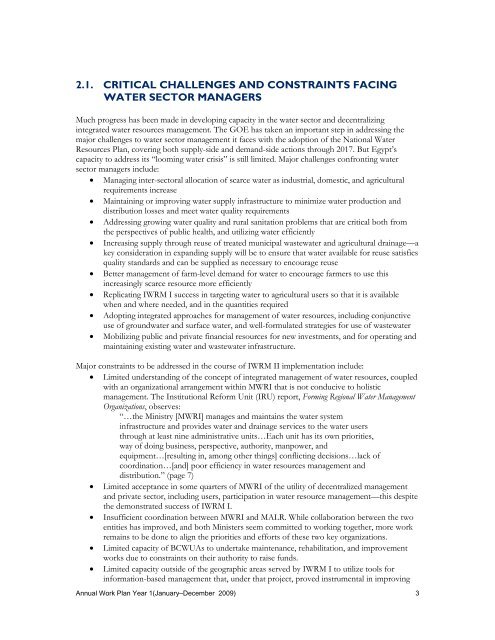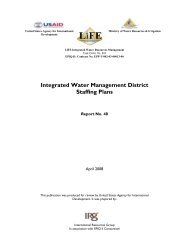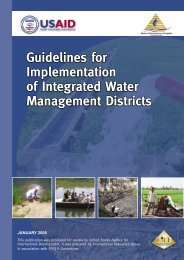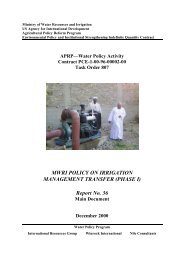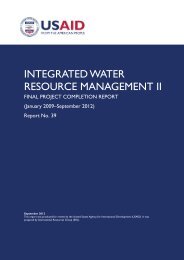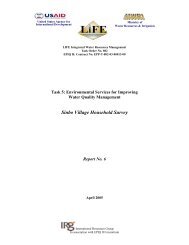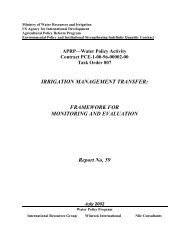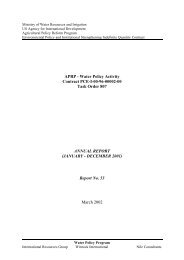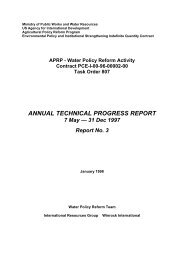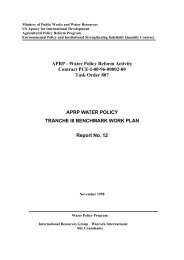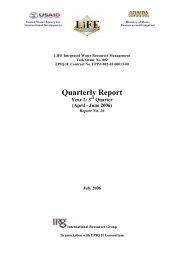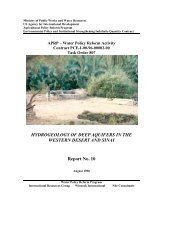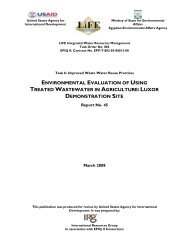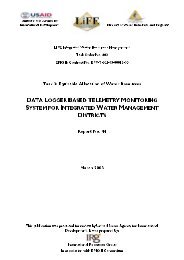ANNUAL WORK PLAN YEAR 1
ANNUAL WORK PLAN YEAR 1
ANNUAL WORK PLAN YEAR 1
Create successful ePaper yourself
Turn your PDF publications into a flip-book with our unique Google optimized e-Paper software.
2.1. CRITICAL CHALLENGES AND CONSTRAINTS FACING<br />
WATER SECTOR MANAGERS<br />
Much progress has been made in developing capacity in the water sector and decentralizing<br />
integrated water resources management. The GOE has taken an important step in addressing the<br />
major challenges to water sector management it faces with the adoption of the National Water<br />
Resources Plan, covering both supply-side and demand-side actions through 2017. But Egypt’s<br />
capacity to address its “looming water crisis” is still limited. Major challenges confronting water<br />
sector managers include:<br />
• Managing inter-sectoral allocation of scarce water as industrial, domestic, and agricultural<br />
requirements increase<br />
• Maintaining or improving water supply infrastructure to minimize water production and<br />
distribution losses and meet water quality requirements<br />
• Addressing growing water quality and rural sanitation problems that are critical both from<br />
the perspectives of public health, and utilizing water efficiently<br />
• Increasing supply through reuse of treated municipal wastewater and agricultural drainage—a<br />
key consideration in expanding supply will be to ensure that water available for reuse satisfies<br />
quality standards and can be supplied as necessary to encourage reuse<br />
• Better management of farm-level demand for water to encourage farmers to use this<br />
increasingly scarce resource more efficiently<br />
• Replicating IWRM I success in targeting water to agricultural users so that it is available<br />
when and where needed, and in the quantities required<br />
• Adopting integrated approaches for management of water resources, including conjunctive<br />
use of groundwater and surface water, and well-formulated strategies for use of wastewater<br />
• Mobilizing public and private financial resources for new investments, and for operating and<br />
maintaining existing water and wastewater infrastructure.<br />
Major constraints to be addressed in the course of IWRM II implementation include:<br />
• Limited understanding of the concept of integrated management of water resources, coupled<br />
with an organizational arrangement within MWRI that is not conducive to holistic<br />
management. The Institutional Reform Unit (IRU) report, Forming Regional Water Management<br />
Organizations, observes:<br />
“…the Ministry [MWRI] manages and maintains the water system<br />
infrastructure and provides water and drainage services to the water users<br />
through at least nine administrative units…Each unit has its own priorities,<br />
way of doing business, perspective, authority, manpower, and<br />
equipment…[resulting in, among other things] conflicting decisions…lack of<br />
coordination…[and] poor efficiency in water resources management and<br />
distribution.” (page 7)<br />
• Limited acceptance in some quarters of MWRI of the utility of decentralized management<br />
and private sector, including users, participation in water resource management—this despite<br />
the demonstrated success of IWRM I.<br />
• Insufficient coordination between MWRI and MALR. While collaboration between the two<br />
entities has improved, and both Ministers seem committed to working together, more work<br />
remains to be done to align the priorities and efforts of these two key organizations.<br />
• Limited capacity of BCWUAs to undertake maintenance, rehabilitation, and improvement<br />
works due to constraints on their authority to raise funds.<br />
• Limited capacity outside of the geographic areas served by IWRM I to utilize tools for<br />
information-based management that, under that project, proved instrumental in improving<br />
Annual Work Plan Year 1(January–December 2009) 3


